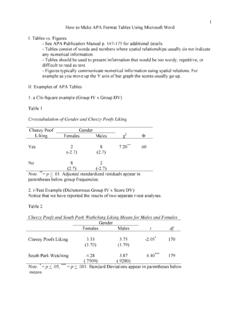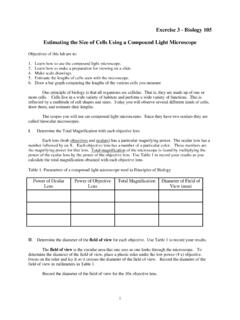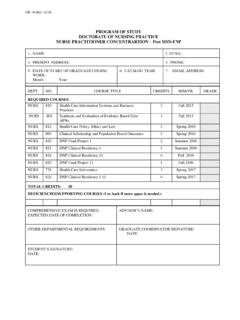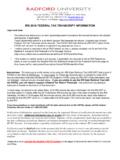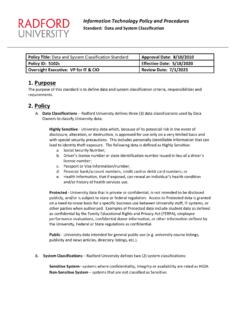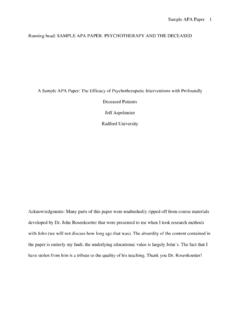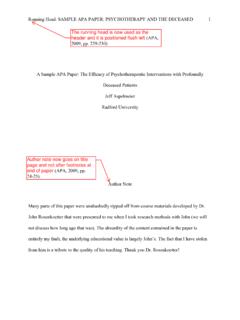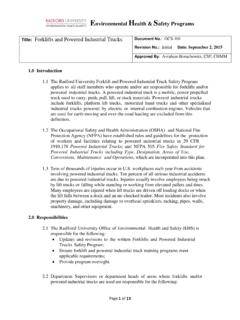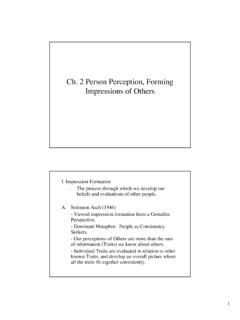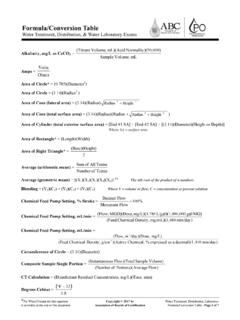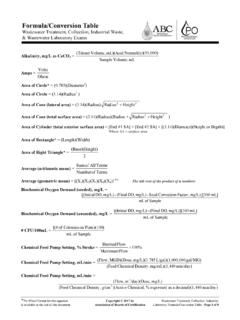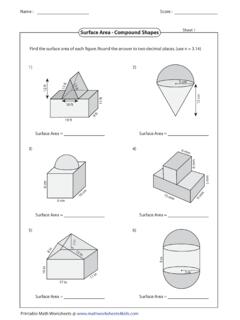Transcription of Area & Volume 1. Surface Area to Volume Ratio - radford.edu
1 1 area & Volume 1. Surface area to Volume Ratio For most cells, passage of all materials gases, food molecules, water, waste products, etc. in and out of the cell must occur through the plasma membrane. As a cell grows bigger, the internal Volume increases and thereby expands the cell membrane. In turn, the Volume increases more rapidly than does the Surface area . Thus, the relative amount of Surface area available to pass materials to a unit Volume of the cell decreases. A large Surface to Volume Ratio means that a small amount of living matter has a large Surface through which nutrients, oxygen and wastes can diffuse.
2 A small Surface to Volume Ratio means that a large amount of living matter has a small Surface through which nutrients, oxygen and wastes can diffuse, which means that such a cell will have more difficulty taking in sufficient nutrients and oxygen, and eliminating wastes. Typically, larger cells result in a smaller Surface to Volume Ratio . For example, many aquatic microorganisms have increased Surface area to increase their drag in the water. This reduces their rate of sink and allows them to remain near the Surface with less energy expenditure. 2. Geometry Basics A. area : area can be understood as the amount of material with a given thickness that would be necessary to fashion a model of the shape, or the amount of paint necessary to cover the Surface with a single coat.
3 area is measured as a square of a length. For instance, units could be in cm2, ft2, etc. Formulas: Rectangle ( )( ) ( ) ( ) Ex.) What is the area of a standard x 11 sheet of paper? Express the solution in square centimeters. ( ) ( ) ( )( ) 2 Now suppose the side lengths of a rectangle were doubled. How this change to the side length change the area ? For practice, let s assume the original rectangle had side lengths of 3 cm and 5 cm.
4 The original area would then be 15 . Doubling the lengths of each side would result in an area of ( )( ) which is 4 times the original area . For simplicity, let the rectangle be a square. As can be seen by the table and graph below, by doubling the length of each side of a square, the new area is the old area multiplied by a factor of 4. Side Length area Side Doubled New area Ratio : 1 1 2 4 2 4 4 16 3 9 6 36 4 16 8 64 5 25 10 100 6 36 12 144 7 49 14 196 0102030405060708090100012345678910 area Length of the Side 3 Some other useful formulas for area include those for the triangle and circle.
5 Triangle Circle B. Volume : Volume can be thought of as the amount of space that a substance or object occupies, or that is enclosed within a container. Volume is measured as the cube of a measure of length, , in cubic units. For instance, cm3, ft3, etc. However, it is also common for other measures to be used such as liters or gallons. To convert between cubic meters and liters, use the scale In most cases, you can calculate the Volume of a cylindrical solid as the area of the base times the height between parallel bases: In the event the prism is a rectangular prism ( , a box), you can use ( )( ) ( ) ( ) ( )( ) Note, the area of the base is dependent on the shape of the base.
6 4 Consider a cube whose sides are doubled in length. How does this affect the Volume ? Side Length Volume Side Doubled New Volume Ratio : 1 1 2 8 2 8 4 64 3 27 6 216 4 64 8 512 By doubling the length by a factor of two, the Volume is increased by a factor of 8. 020040060080010000246810 Volume Length of the Side 5 The Surface area of an object is the sum total of the areas of each of the faces of the object. In the case of a rectangular prism, On the other hand, if the prism has circles as bases, then it is called a cylinder.
7 Recall the area of a circle was defined as Therefore the Volume of a right circular cylinder is Finally, the Volume of a sphere is and the Surface area is ( )( ) and the Surface area is 6 3. Examples Ex.) A circular oil spill in the Gulf of Mexico covers 24 square miles. (a) What is the diameter of the oil spill? ( ) The diameter is approximately mi (b) How many gallons of oil have been spilled if the layer is a quarter inch thick?
8 ( ) ( ) ( ) ( ) ( ) ( ) ( )( )( ) There are approximately gallons of oil spilled. Ex.) A river is 1800 ft wide and 20 ft deep on average. It flows at mph. How many cubic feet flow down the river each second? Each second 132,000 cubic feet flows down the river. 7 Ex.) The bacteria Escherichia coli (E coli) are about 3 m long and 1 m in diameter.
9 (a) Assuming a cylindrical shape, what are the Volume and the Surface area ? ( ) ( ) ( )( ) ( ) ( ) ( )( ) ( ) ( ) ( ) ( ) ( ) (b) What is the Surface to Volume Ratio ? (c) What is the mass of a single cell, if we assume its density is 10% more than that of water? The density of water is approximately 1000 . 10% of this is 100 . Therefore the density of a single cell is assumed to be.
10 The Volume of the cell is approximately Converting 8 Ex.) Suppose that a eukaryotic cell has the shape of a sphere with diameter 24 m. (a) What are the Volume and the Surface area ? ( ) ( ) ( ) ( ) (b) What is the Surface to Volume Ratio ? (c) What is the mass of the cell, again assuming that the cell density is 10% higher than that of water?
